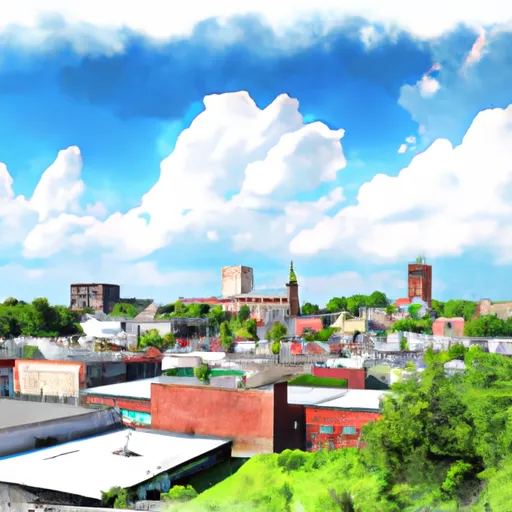-
 Snoflo Premium
Snoflo Premium
Get unlimited access to all our content
With no Ad interruptions! - Start Your Free Trial Login with existing account
Trinity
Eden Index
Climate
8.1
•
Recreation
2.2
•
Community
•
Safeguard
4.0/10

Trinity, Kentucky, located in the northeastern part of the state, experiences a humid subtropical climate. Summers are hot and humid, with temperatures ranging from the mid-80s to the low 90s Fahrenheit. Winters are generally mild, with average temperatures in the mid-30s to low 40s. Rainfall is evenly distributed throughout the year, with an annual average of around 45 inches.
The hydrology constituents in Trinity are mainly influenced by the Ohio River, which borders the city to the north. The river provides opportunities for boating, fishing, and other water-based activities. Trinity is also home to several streams and creeks, adding to the local water resources.
Outdoor recreation enthusiasts in Trinity have plenty of opportunities to explore the surrounding natural beauty. The area is dotted with parks and green spaces that offer hiking trails, picnic areas, and wildlife observation. Additionally, Trinity's proximity to the Daniel Boone National Forest provides access to even more outdoor activities like camping, hunting, and horseback riding. Overall, Trinity offers a diverse range of outdoor recreation opportunities for residents and visitors alike.
What is the Eden Index?
The Snoflo Eden Index serves as a comprehensive rating system for regions, evaluating their desirability through a holistic assessment of climate health, outdoor recreation opportunities, and natural disaster risk, acknowledging the profound impact of these factors on livability and well-being.
Climate Health Indicator (CHI): 8.1
Trinity receives approximately
1194mm of rain per year,
with humidity levels near 84%
and air temperatures averaging around
12°C.
Trinity has a plant hardyness factor of
6, meaning
plants and agriculture in this region thrive during a short period during spring and early summer. Most
plants will die off during the colder winter months.
By considering the ideal temperature range, reliable water supplies, clean air, and stable seasonal rain or snowpacks, the Climate Health Indicator (CHI) underscores the significance of a healthy climate as the foundation for quality living.
A healthy climate is paramount for ensuring a high quality of life and livability in a region, fostering both physical well-being and environmental harmony. This can be characterized by ideal temperatures, reliable access to water supplies, clean air, and consistent seasonal rain or snowpacks.
Weather Forecast
Streamflow Conditions
Middle Ohio-Little Miami
Area Rivers
Middle Ohio-Little Miami
Snowpack Depths
Middle Ohio-Little Miami
Reservoir Storage Capacity
Middle Ohio-Little Miami
Groundwater Levels
Recreational Opportunity Index (ROI): 2.2
The Recreational Opportunity Index (ROI) recognizes the value of outdoor recreational options, such as parks, hiking trails, camping sites, and fishing spots, while acknowledging that climate plays a pivotal role in ensuring the comfort and consistency of these experiences.
Access to outdoor recreational opportunities, encompassing activities such as parks, hiking, camping, and fishing, is crucial for overall well-being, and the climate plays a pivotal role in enabling and enhancing these experiences, ensuring that individuals can engage in nature-based activities comfortably and consistently.
Camping Areas
| Campground | Campsites | Reservations | Toilets | Showers | Elevation |
|---|---|---|---|---|---|
| Willie Begley Memorial RV Park | None | 954 ft | |||
| Clay Lick - DFWR | None | 740 ft | |||
| Paragon | 9 | 731 ft | |||
| Trace Branch - Buckhorn Lake | 20 | 865 ft | |||
| Buckhorn Dam Rec Area - Buckhorn Lake | 33 | 740 ft | |||
| North Fork - DFWR | None | 734 ft | |||
| Twin Knobs Rec Area | 623 | 773 ft | |||
| Clear Creek Rec Area | 23 | 762 ft | |||
| Zilpo Rec Area | 368 | 764 ft |
Nearby Ski Areas
Catastrophe Safeguard Index (CSI):
The Catastrophe Safeguard Index (CSI) recognizes that natural disaster risk, encompassing floods, fires, hurricanes, and tornadoes, can drastically affect safety and the overall appeal of an area.
The level of natural disaster risk in a region significantly affects safety and the overall livability, with climate change amplifying these risks by potentially increasing the frequency and intensity of events like floods, fires, hurricanes, and tornadoes, thereby posing substantial challenges to community resilience and well-being.
Community Resilience Indicator (CRI):
The Community Resilience Indicator (CRI) recognizes that education, healthcare, and socioeconomics are crucial to the well-being of a region. The CRI acknowledges the profound impact of these elements on residents' overall quality of life. By evaluating educational resources, healthcare accessibility, and economic inclusivity, the index captures the essential aspects that contribute to a thriving community, fostering resident satisfaction, equity, and social cohesion.

